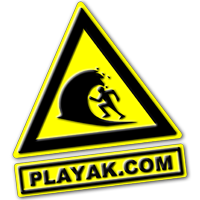[please login to make this ad block disappear]
Articles
Corporate Kayak Compromising, part 1
 |
Do you think you paddle the best kayak for you? We bet you don't ! |
(Warning: The following text was written in good will. It is based on individual experiences, 18 years of kayaking, 16 years of competing and 7 years in the kayak industry. It only represents the author's personal opinions. Most thoughts and cases are written from a competitive playboater's point of view.)
Let's face it: all kayak companies are money making machines. They must sell kayaks. This forces us, kayak designers, to compromise on design and engineers to compromise on materials and even on technical issues. Money talks!
In this first article we'll take a look at the design compromises.
Part 1. Kayak Design Comprising
High performance kayaks are harder to paddle

Harder and sharper edges, more concave sidewalls, long carving edges and less rockered, narrow hulls make boats perform better. These properties also make boats different to paddle. In case of an error or poor style it usually means that the boat is more difficult to paddle.
Most kayakers are too lazy to really learn how to paddle a new boat. If you get your ass kicked due to shitty edge control, it is not a problem of the sharp concave carving hull. If your subswallow-designed stern subs when you paddle poorly, it is not a rocker problem. Right, huh?

So, too often, designers create better kayaks and then soften out the design for sales. Similar compromises are done in volume distribution and rocker, etcetera, making the kayak easier to paddle. And all that is for sales and sales only. Some companies even go further. They design the same kayak year after year. With minimal changes, each new design will feel good immediately. Creative?
High performance kayaks are uncomfortable
Kayak must be the right size for you and your style. In some cases that means you need the smallest kayak that you fit in. That would, in most cases, be a great wheeling boat. But if you are tall and generally large you will have to sit hours in a medieval torture device.
Power transfer from body to kayak is essential for the feel. Simple test: Try jumping from a soft platform, like a bed and then from a hard surface, like a floor. Did you go equally high or far? The kayaks should have rock solid fittings with minimal soft pads. For example, foam footrests are usually way too soft for real leg usage.
There is also a significant problem in us, the paddlers, being shaped very
differently. There should be many different seat options etc... but once again,
it is 100% money issue.
I’m lucky to have small feet and short inseam. In my case, choosing a
high performance boat means just choosing the boat that performs like I want.
I’m into larger boats for bigger air. I usually look for 50+ gallons.
I will sacrifice some wheelability and manouverability for air and amplitude.

It is all about personal choice. The kayak industry is aware of this too. Nowadays there are wave kayaks and hole kayaks and several different boats for different styles. If you want to track race, get a race car like a Porsche GT3 and not a van. Please do not moan that your shopping does not fit in it.
High performance solutions do not fit all paddlers
If you want to feel tightly fit and keep the performance really high there are many solutions. Lap belts, overtrusters and thigh straps etc. Most of those are plain dangerous if used wrong or incompetently. You have been warned!
Summary
To sum up the performance issue, I would like to add one more line from Corran Addison's Air Force 1 DVD: '' There is no such thing as a too highly performing kayak. The poorer your skill level, the better the kayak you need. Great kayakers can paddle anything.''
Next time we will look at kayak materials.
CU in the eddy !
Marko
Hakolahti
Designer
Drakkar Kayaks
The Corporate Kayak Compromising series
- Part 1, Design Compromises
- Part 2, Materials
- Part 3, Marketing and Sales


